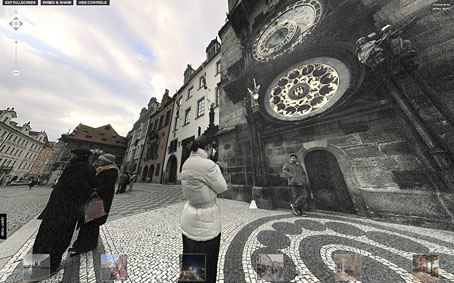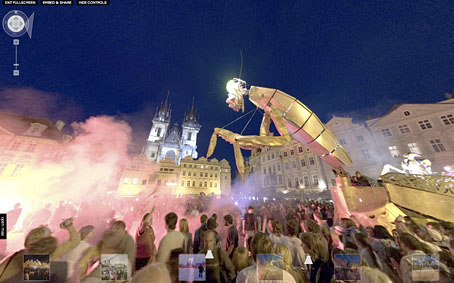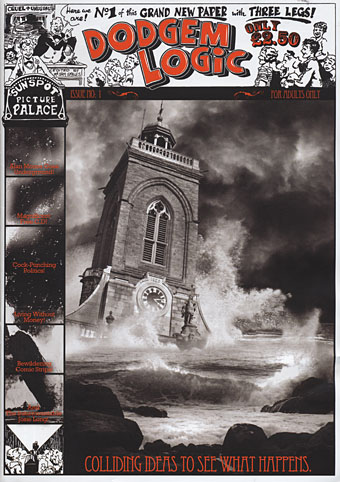Bacon Agonistes | John Richardson on Francis Bacon.
Month: November 2009
Prague panoramas
Now that we’re into the dismal weather, sombre views of Old Prague’s splendour seem appropriate. The pages at 360 Cities have a lot of Prague panoramas—76 in all—including many more of the Viriconium-esque Giant Mantis performance I linked to a few years ago. A shame they don’t do this every year.
Previously on { feuilleton }
• Eno’s Luminous Opera House panorama
• Callanish Standing Stone panoramas
• Jaipur Observatory panoramas
• Infinite reflections
• Large Hadron Collider panoramas
• Passage des Panoramas
• Bruges panoramas
• Paris panoramas
• Venice panoramas
• St Pancras in Spheroview
• Karel Plicka’s views of Prague
• Giant mantis invades Prague
• Whirling Istanbul
Dodgem Logic
You need this, boys and girls, yes you do. Dodgem Logic is the first worthwhile independent culture mag this country has produced since the sorely-missed Strange Things Are Happening. Perhaps significantly, both those titles featured Mr Alan Moore, being interviewed in Strange Things and presiding over the new title as resident magus and eminence gris-gris.
“…we’ve tried to resurrect a spirit of the 60s underground papers, but without the look or ambience or some of the oversights. There were a lot of very good ideas that emerged from the 60s underground. It was the first place I heard about women’s liberation – as we used to call it then – or gay liberation. They were fanatically anti-war. Many of their most extreme political statements, such as the fact that sometimes the police kill people, or that sometimes we make deals with dictators and criminal governments that we keep quiet about – these things are pretty much standard stuff of conversation these days and not reserved purely for bearded wild-eyed burbling radicals (chuckles).” (More.)
Among other delights, there’s a page of Alan’s where he returns to cartooning (below) with a paean to my favourite drawing pen, the Rotring Rapidograph, Melinda Gebbie writing on feminism, Kevin O’Neill with a WTF of cosmic proportions, and much more, including a smart feature on how to reclaim local land which the council won’t use. All this and a free CD! Who says we can’t have good things?
Update: I should have noted that Americans can order Dodgem Logic through Top Shelf.
Previously on { feuilleton }
• International Times archive
• The Realist
• Revenant volumes: Bob Haberfield, New Worlds and others
• Oz magazine, 1967-73
• Alan Moore interview, 1988
• Strange Things Are Happening, 1988-1990
The art of Sydney R Jones, 1881–1966
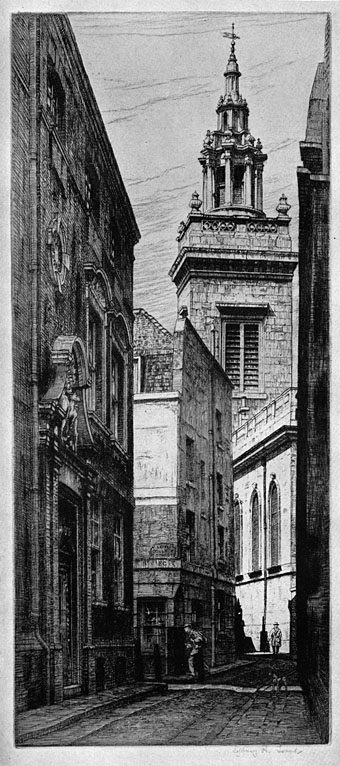
Church of St Michael Paternoster Royal and Innholder’s Hall (1927).
One of the better secondhand book discoveries of the past couple of years was London Triumphant, a collection of etchings and pencil drawings of the city’s streets and buildings by Sydney R Jones. The etchings immediately seized my attention, being the kind of closely-hatched architectural renderings which I enjoy, but the book as a whole is very good as it details the artist’s wanderings with a young student friend through the city. Jones established himself as an illustrator of books with titles like The Manor Houses of England and The Charm of the English Village. His London book appeared in July 1942 and collected many of his earlier views of the city as a deliberate morale boost for the populace who were watching the capital’s historic buildings yield to the bombs of what he calls “the foul Hun”. Jones catalogues the destruction with dismay as he recounts the history of the city from Roman times but ends on a note of defiant optimism, wondering what new metropolis might rise from the destruction. He mentions in passing that cult locale of mine, the Essex Street Water Gate, but doesn’t provide a drawing unfortunately. The book proved to be very popular, and the copy I found is a fifth printing from 1947.
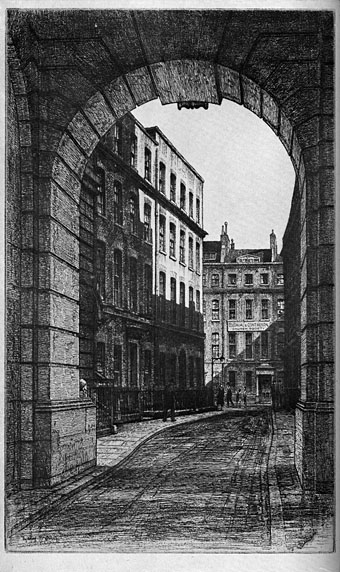
Serjeant’s Inn, Fleet Street (1926).
This week’s book purchase was a welcome find, then, being London Triumphant‘s sequel, Thames Triumphant, in which Jones follows the course of the river from its spring at Coberley, through Oxford and on down to Greenwich. There aren’t as many dramatic views this time, and many of the country scenes have that kind of polite blandness about them which you find in much book illustration of the period. But Jones does provide a couple of his speculative and spectacular views over the city, including the one below which shows the City of London as it was in 1939. Much of the foreground was bombed flat during the war so a drawing such as this provides a valuable record of how London’s financial centre looked before the arrival of the Luftwaffe and the office blocks. Jones lived to see much of the subsequent reconstruction—I can’t help but wonder what he made of it all.
The City of London, 1939; click for a bigger view.
Elsewhere on { feuilleton }
• The etching and engraving archive
• The illustrators archive
Previously on { feuilleton }
• Pite’s West End folly
• Jessie M King’s Grey City of the North
• Architectural renderings by HW Brewer
• The Essex Street Water Gate, London WC2

